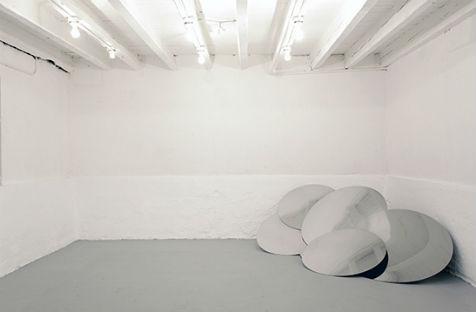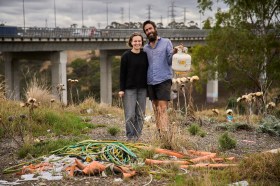Each year the Australian Centre for Contemporary Art (ACCA) commissions a small group of emerging Australian artists, giving them their first chance to step into a big spotlight in NEW.
NEW starts without any preconception of what form or shape the exhibition may take, concentrating on using the opportunity to undertake a program of studio visits and meetings with artists to discuss their work and ideas for works that they would like to make.
Artists are chosen based on their practice and particular perspective on a subject and/or media. Most featured artists have something that drives them to persevere; working in a certain way that distinguishes their output from other artists’ works.
I am also drawn to artists who are willing to take risks and push an idea as far as they can, who continually question the decisions they make and aren’t afraid to change course if need be to arrive at the best outcome.
For NEW13, I tried to keep the selection process reasonably spontaneous. It can be easy to get caught up in a bureaucratic way of thinking: making decisions based on creating a broad geographical or media representation, for example, isn’t necessarily a good reason to choose an artist or leads to the best exhibition.
With an exhibition of ‘new talent’ it is important to think about timing too. Is this a good time for the artist to step up to the broader public context and comparative format of an exhibition like NEW at ACCA?
Even though NEW is not a thematic exhibition, certain tendencies emerged from the research undertaken and I have used these as a guide to the final selection of artists.
Therefore there are a number of threads in NEW13: studies of the behaviour of the body moving through space and time; the idea of each reproduction as a new form of life that relates to the original but is its own unique entity; an exploration of the politics of representation; the notion that progress may not necessarily be in one direction and that a more linear and lateral approach may be required in which media and history is revisited and a dialogue created.
I had come across Jess McNeil’s videos in exhibitions over a number of years but met her for the first time in anticipation of NEW13. MacNeil embraced the challenge of making new work and testing the boundaries of her practice for NEW. She has detoured from her usual digital format to 16mm film to explore human movement through space and across time in the wintery landscape of London’s Trafalgar Square. Shot over one day, the people who cross the square generate what happens in the work. Whereas in previous videos, the passing people have been digitally removed from the footage, in this new work McNeil will recreate digital effects utilising analogue processes.
Alex Martinis Roe is part of a young generation of artists that conceives of art as an active verb – a platform for review and practice. She questions the idea of art as representation and proposes forms of engagement in which the personal Is political is enacted in very practical and tangible ways. Following on from her project Genealogies; Frameworks for Exchange 2011-2012, which made female authorial genealogies visible and practicable among an evolving network of interlocutors and audiences, her work for NEW13 The Practice of Doing will recontextualise the radical feminist practices devised by the Milan Women’s Bookstore Collective in a sound installation featuring stories of friendship and mutual support that fosters entrustment as a way for women to relate to each other.
Sanne Mestrom has been producing ambitious installations in recent years and her work is part of a broader interest in the expanded field of sculpture. She makes use of sculptural processes of assemblage, casting and copying to forge new connections and relations with key moments in art history. Mestrom will focus on two modernist masters, Pablo Picasso and Giorgio Morandi, painters exploring the space between figuration and abstraction. In response to key works by each of these well-known artists she will create what she has coined ‘three dimensional collages’ that reinterpret the ethos of these original works; their form, significance, original context as well as continuing cultural influence, as well as personal resonance for the artist.
I had been following Scott Mitchell’s practice as part of the group OSW (with Terri Bird and Bianca Hester) and was curious to learn more about his individual practice and its incorporation of reusability and exchange. Since the beginning of January, Mitchell has been tracking the passage of sun light through out the day through the three windows and entryways into ACCA. He has also been conducting tests on how he can harness this precious and fleeting light source and channel into the far recesses of ACCA’s hermetic large gallery using a series of mirrors. His installation will involve multiple mirrors installed on the exterior and through the exhibition spaces at ACCA to produce a precious beam of light that he will utilise to illuminate an object in the gallery space.
Joshua Petherick takes the idea of reproduction, of image generation and proliferation as far as he possibly can pushing the boundaries of any given device beyond its designed capability. There is a circularity and repetition in much of Petherick’s output that relates it to methods adopted by a number of the other artists in NEW13. Petherick is building on his recent work, which involved a ‘conversation’ between a flat bed scanner and iPhone as they began to survey, record and transcribe each other. In the resulting series of video screens in NEW13 he will provide insight into processes that we cannot usually physically see, both literally and also in a much wider sense.
Benjamin Forster also works with everyday technologies and sometimes literally pulls them apart but also devises ways to reprogram them to convey new insights and poetic conclusions. His installation in last year’s Primavera was a work I particularly responded to. Forster’s practice explores drawing, bringing together digital and biological technologies, installation and print to trace boundaries of logic, economy and the role of the artist in art making. For NEW he will present a number of ‘incomplete propositions’, attempts to rewire, rewrite and reprogram different technological formats (LCD screens, lap top and iPhone) exploring their power as conducting communication devices.
While Linda Tegg has become known for her installations and photography with live animals, for NEW13 she is developing ‘Tortoise’ a work that has involved her collaborating with a group of dancers wearing mirrored discs which she has choreographed for a video performance. Tegg is making use of the National Gallery of Victoria’s entrance court as monolithic stage set. Her dancers located under the mirrored exoskeleton become an amorphic and mutating organism – a slowly moving blind spot in the gallery space.
New 13 is on at the Australian Centre for Contemporary Art, 11 Sturt St, Southbank, Victoria from 16 March to 13 May. Admission is free.





